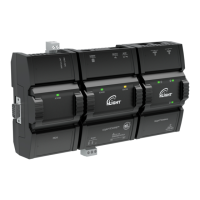Set the DNS IP address of the Domain Name System (DNS) servers in routers and in IP controllers that have manually-
configured IP parameters. Between one and three DNS IP address is usually provided by the Internet Service Provider
(ISP). The second and third DNS addresses are for failover should the first DNS become unavailable.
If you do not know the address of your DNS server(s), try the following publicly-available DNS server addresses: primary =
8.8.8.8 and secondary = 4.4.4.4
Some ECLYPSE controller services use DNS to resolve Web addresses thereby allowing the service to operate. See
ECLYPSE Services that Require Internet Connectivity.
About Routers, Switches, and Hubs
The differences between a hub, switch, and router are discussed in the table below.
Device Type Description
Hub
Every incoming data packet is repeated on every other port on the device. Due to this, all traffic is made available on all
ports which increase data packet collisions that affect the entire network, thus limiting its data carrying capacity.
Switch
A switch creates a one-to-one virtual circuit that directs IP packets directly to the port that the destination computer is
connected to.
Router
Like a switch, a router learns the IP addresses of all devices connected to any of its RJ-45 ports to create a routing table. If
a data packet arrives at the router’s port with a destination IP address that is:
– Found in the router’s routing table, the router forwards the data packet to the appropriate
port for the device that has this IP address.
– For a network with a different network ID than the current network ID, the router forwards
the data packet to the uplink port where the next router will again either recognize the net-
work ID and route the data packet locally or again forwards the data packet to the uplink
port. By being exposed to traffic, a router adds to its routing table the pathways necessary
to resolve a data packet's pathway to its final destination, by passing through one or more
routers if necessary.
Connecting a Router
The way a router is connected to other devices changes its function.
1
UPLINK
2 3 4
1
UPLINK
2 3 4
ROUTER
A
ROUTER
B
Connection to use ROUTER A as a router
To
Device
To
Device
To
Device
To
Device
To
Device
To
Device
To
Device
To
WAN
1
UPLINK
2 3 4
1
UPLINK
2 3 4
ROUTER
A
ROUTER
B
Connection to NOT use ROUTER A as a router
To
Device
To
Device
To
Device
To
Device
To
Device
To
Device
To
WAN
UPLINK
Function is
Not Used
Figure2: The Way a Router is Connected Changes its Function
On some routers, the uplink port is marked as WAN (Wide Area Network) and the numbered ports are to be connected to
the LAN (Local Area Network) devices.
IPv4 Communication Fundamentals
16
nLight ECLYPSE

